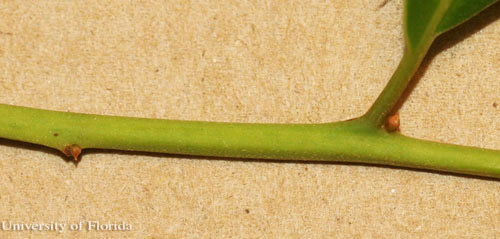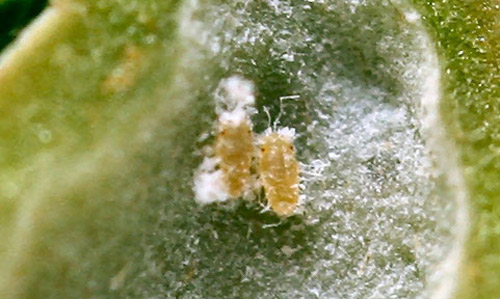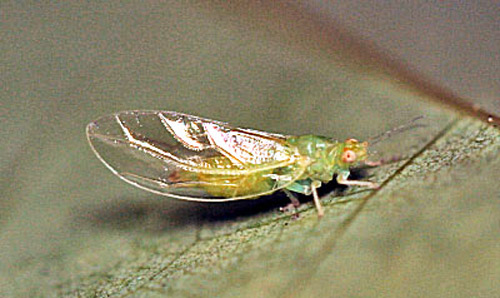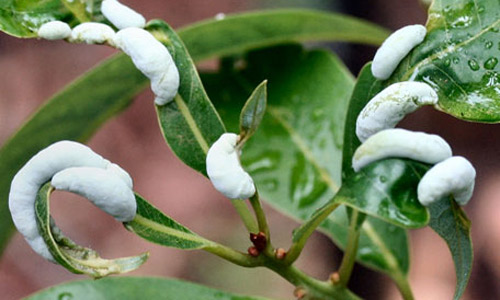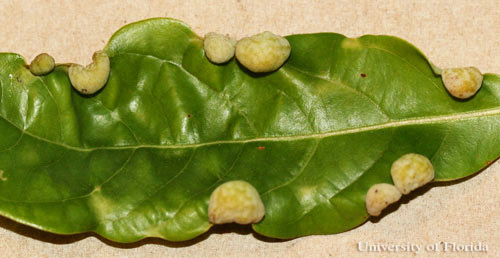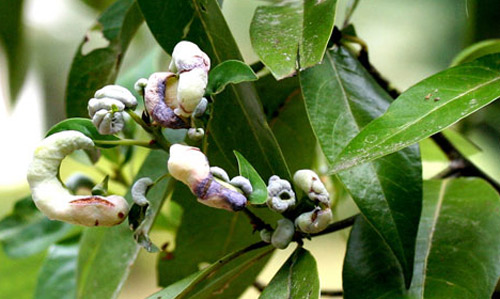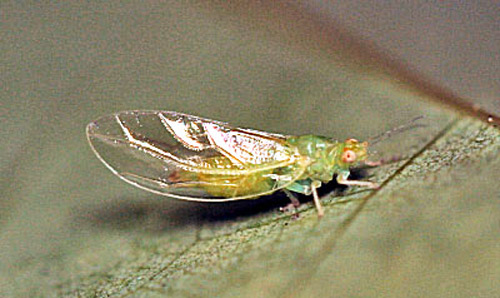common name: red bay psyllid
scientific name: Trioza magnoliae (Ashmead) (Insecta: Hemiptera: Sternorrhyncha: Psyllidae)
Introduction - Distribution - Description - Life Cycle and Biology - Economic Importance - Selected References
Introduction (Back to Top)
The red bay psyllid, Trioza magnoliae (Ashmead), was originally called the bay magnolia psyllid (Ashmead 1881) because the host plant from which it was originally described was believed to be the plant that is now known as sweet bay (Magnolia virginiana L.) which is in the family Magnoliaceae. However, there are no known verifiable records of this insect on plant species other than native species of Persea bay trees (Mead 1967) in the family Lauraceae. This almost certain error is because of the similarity in general appearance of these plants which are all called bays. Sweet bay and the Persea bays are commonly confused by those who are not familiar with the diagnostic characters for separating them. Although there are a variety of characteristics to separate species belonging to the genus Magnolia from Persea species, one that is always observable is the presence on Magnolia species of a stipular scar that forms a ring around the stem at the node. This scar is not present in Persea species.
Figure 1. Sweet bay, Magnolia virginiana L., twig showing stipular scars. Photograph by Donald W. Hall, University of Florida.
Figure 2. Silk bay, Persea borbonia (L.) Spreng, twig showing lack of stipular scar. Photograph by Donald W. Hall, University of Florida.
There are three forms of native Persea bay trees in the southeastern U.S.:
- red bay, Persea borbonia (L.) Spreng.,
- silk bay, Persea borbonia (L.) Spreng. var. humilis (Nash) L.E.Kopp,
- swamp bay, Persea palustris [Raf.]Sarg.
(Wunderlin and Hansen 2003, Wunderlin and Hansen 2008).
There are minor morphological differences, and the three forms are found in soils of different moisture levels with Persea borbonia var. humilis being found in drier areas. All are attacked by Trioza magnoliae.
Most, but not all, species of psyllids are narrowly host specific (Hodkinson 1984), and Trioza magnoliae is not known to use even other species of Lauraceae besides Persea borbonia and Persea palustris as hosts. Therefore, it will be referred to as the red bay psyllid.
Red bay psyllid galls are almost universally present on Persea borbonia and Persea palustris. In fact, they are so omnipresent that Nelson (1994) has suggested using the presence of the galls as an identification clue to these species of Persea.
Distribution (Back to Top)
Red bay psyllids are found throughout the range of their Persea host plants which includes the southeastern coastal plain from Delaware to Texas, USA (USDA 2008).
Description (Back to Top)
Eggs are not known. Young nymphs are yellow and flattened. Mature nymphs are green with orange wing pads, red eyes, and short black antennae and sparse waxy filaments. Ashmead (1881) and Crawford (1914) give detailed descriptions of the life stages. Adults are described as elongate-oval and pale greenish-yellow with a pointed abdomen. They have yellow ocelli and 10-segmented antennae. The wings are transparent and lanceolate with pale green veins. Legs are pale greenish-yellow with the basal tarsal segment broadly flattened. Sometimes there are brown stripes on the thorax (Johnson and Lyon 1991). Adults are 3 to 4 mm. in length (Ashmead 1881, Mead 1963) and resemble miniature cicadas.
Figure 3. Dissected gall with immature nymphs of the red bay psyllid, Trioza magnoliae (Ashmead). Photograph by Donald W. Hall, University of Florida.
Figure 4. Dissected gall with mature nymphs of the red bay psyllid, Trioza magnoliae (Ashmead). Photograph by Donald W. Hall, University of Florida.
Figure 5. Adult red bay psyllid, Trioza magnoliae (Ashmead). Photograph by Donald W. Hall, University of Florida.
Life Cycle and Biology (Back to Top)
Ashmead (1881) speculated that eggs are laid under the epidermis of leaves. As the newly hatched nymphs begin to feed, the margin of the leaf begins to curl and ultimately completely envelops the nymphs in an elongated pocket-like gall. The galls may be over 1/2 inch in length. When the leaves are attacked just as they are opening, they may be severely distorted. There may be more than one gall per leaf. As many as eight galls per leaf and an incidence of up to 80% of leaves with galls has been reported by Moon and Stiling (2004).
Figure 6. Galls of the red bay psyllid, Trioza magnoliae (Ashmead), on Persea borbonia. Photograph by Donald W. Hall, University of Florida.
Figure 7. Galls of the red bay psyllid, Trioza magnoliae (Ashmead), on leaf of Persea borbonia var. humilis. Photograph by Donald W. Hall, University of Florida.
Figure 8. Persea borbonia leaves severely deformed by galls of the red bay psyllid, Trioza magnoliae (Ashmead). Photograph by Donald W. Hall, University of Florida.
Figure 9. Galls of the red bay psyllid, Trioza magnoliae (Ashmead), on swamp bay, Persea palustris (Raf.) Sarg. Photograph by Donald W. Hall, University of Florida.
Many species of Sternorrhycha produce honeydew as a mechanism to dispose of excess carbohydrates. For species developing in galls or other confined spaces, the sticky honeydew could potentially pose a suffocation hazard. Typically the nymphs of these species are coated with wax so the honeydew does not stick to them, and they may also hold the honeydew droplet at the tip of the abdomen until they coat it with wax (Mittler and Douglas 2003).
Figure 10. Dissected gall with early instar nymph of the red bay psyllid, Trioza magnoliae (Ashmead), and honeydew droplets covered with wax. Photograph by Donald W. Hall, University of Florida.
Psyllids have endosymbiotic microorganisms in association with their gut (Spalding and Von Dohlen 1998) that are presumably beneficial to them in nutrition — possibly providing vitamins and other nutrients not present in the phloem sap upon which they feed.
When the psyllid nymphs are mature, the gall splits along the edge to release them. The cast skins of the last instar nymphs may be seen adhering to the undersides of leaves (Mead 1963). Mead stated that adults seem to emerge from April to June with peak emergence in mid-May. However, the adult shown above was photographed on 10 February 2009. Mead (1963) reported that the red bay psyllids are probably single-brooded, but that in Florida there are reports of galls with nymphs for all months. Hodges et al. (2006) also reported that it is univoltine. However, Moon and Stiling (2004) state that it is multivoltine in Florida with at least three overlapping generations.
Figure 11. Cast skin of last instar nymph, red bay psyllid, Trioza magnoliae (Ashmead). Photograph by Donald W. Hall, University of Florida.
Figure 12. Adult red bay psyllid, Trioza magnoliae (Ashmead). Photograph by Donald W. Hall, University of Florida.
In spite of the fact that red bay psyllid nymphs live inside a gall, they are vulnerable to natural enemies. Moon and Stiling (2004) reported parasitism levels of 25 to 45% by Psyllidephagus sp., an encyrtid wasp. Parasitized nymphs can be recognized by their darkened color. The cecidomyiid midge, Thrypsobremia thripivora Gagné, preys both on thrips that live in curled leaf shelters and on red bay psyllid nymphs (Gagné and Bennett 1993). Also, small insectivorous birds have been observed opening the galls to feed on the nymphs (Orsorio 2001).
Economic Importance (Back to Top)
Fresh leaves of Persea borbonia and Persea palustris are aromatic when crushed and can be used in place of commercial bay leaves in cooking (Orsorio 2001). The wood has been used locally as a hardwood in cabinetwork and boat-building (USDA 1990). Both species are valuable as food sources for wildlife. Bears and birds feed on the fruit, and deer browse on the foliage (Haehle and Brookwell 2004, USDA 1990). They also serve as host plants for a variety of native insects including the beautiful palamedes swallowtail butterfly, Papilio palamedes (Drury) (Hall and Butler 1998).
Leege (2006) studied the effects of red bay psyllids on Persea borbonia and found that galled leaves were smaller and aged more rapidly and that shoots with galls did not grow as well and produced fewer flowers. However, in her study, there was no correlation between gall load and seed production. The main impact of the galls is aesthetic for homeowners and park managers. Haehle and Brookwell (2004) recommend using Persea borbonia in background plantings because of the disfiguring galls. Orsorio (2001) states, "The galls cause absolutely no harm and no steps should be taken to cure the tree." Red bay psyllids are not believed to attack avocado, Persea americana Mill.
Persea borbonia as well as other southeastern U.S. Lauraceae and some of the organisms that are dependent on it are now threatened by a Raffaelea sp. lethal wilt-causing fungal symbiont of the recently introduced exotic red bay ambrosia beetle Xyleborus glabratus Eichhoff (Scolytinae: Curculionidae) (Mayfield 2006, Fraedrich 2008).
Selected References (Back to Top)
- Ashmead WH. 1881. On the Aphididae of Florida, with descriptions of new species. Canadian Entomologist 13: 223-225.
- Crawford DL. 1914. A Monograph of the Jumping Plant-lice or Psyllidae of the New World. United States National Museum Bulletin 85. 186 pp.
- Fraedrich SW, Harrington TC, Rabaglia RJ, Ulyshen MD, Mayfield AE, Hanula JL, Eickwort JM, Miller DR. 2008. A fungal symbiont of the red bay ambrosia beetle causes a lethal wilt in red bay and other Lauraceae in the Southeastern United States. Plant Disease 92: 215-224.
- Gagné RJ, Bennett FD. 1993. Two new species of Lestodiplosini (Diptera: Cecidomyiidae) preying on Homoptera and Thysanoptera in southern Florida. Florida Entomologist 76: 341-348.
- Haehle RG, Brookwell J. 2004. Native Florida Plants: Low-maintenance Landscaping and Gardening. Taylor Trade Publishing. New York. 360 pp.
- Hall DW, Butler JF. (2007). Palamedes swallowtail, Papilio palamedes (Drury). Featured Creatures.
- Hodges A, Buss E, Mizell RF. 2006. Insect Galls of Florida. University of Florida. Gainesville, Florida. SP 343. 130 pp.
- Hodkinson ID. 1984. The biology and ecology of the gall-forming Psylloidea (Homoptera). In Ananthakrishnan TN (editor). Biology of Gall Insects. E. Arnold. London. pp. 59-77.
- Johnson WT, Lyon HH. 1991. Insects That Feed on Trees and Shrubs. 2nd edition, revised. Comstock Publishing Associates. Ithaca, New York. pp. 456-457.
- Leege LM. 2006. The relationship between psyllid leaf galls and red bay (Persea borbonia) fitness traits in sun and shade. Plant Ecology 184: 203-212.
- Mayfield AE III. (2006). The red bay ambrosia beetle, Xyleborus glabratus Eichhoff (Scolytinae: Curculionidae). FDACS-Division of Plant Industry. (Revised by Dr. Greg Hodges - Division of Plant Industry and Jeff Eickwort - Division of Forestry on July 30, 2009).
- Mead FW. (1963). A psyllid, Trioza magnoliae (Ashmead). FDACS-Division of Plant Industry.
(16 January 2015). - Minno MC, Butler JF, Hall DW. 2005. Florida Butterfly Caterpillars and their Host Plants. University Press of Florida. Gainesville, Florida. 341 pp.
- Mittler TE and Douglas AE. 2003. Honeydew. In Resh VH and Cardé R (editors). Encyclopedia of Insects. Academic Press. New York. pp. 523-526.
- Moon DC, Stiling P. 2004. The influence of salinity and nutrient gradient on coastal vs. upland tritrophic complexes. Ecology 85: 2709-2716.
- Nelson G. 1994. The Trees of Florida: A Reference and Field Guide. Pineapple Press, Inc. Sarasota, Florida. 338 pp.
- Orsorio R. 2001. A Gardener's Guide to Florida's Native Plants. University Press of Florida. 304 pp.
- Spalding AW, Von Dohlen CD. 1998. Phylogenetic characterization of bacterial endosymbionts in psyllids (Hemiptera: Sternorrhyncha). Molecular Biology and Evolution 15: 1506-1513.
- USDA. (1990). Silvics of North America: Volume 2, Hardwoods. (21 January 2015).
- USDA. (2008). Plants Database. Natural Resources Conservation Service. http://plants.usda.gov/ (21 January 2015).
- Wunderlin RP, Hansen BF. 2003. Guide to the Vascular Plants of Florida. 2nd ed. University Press of Florida. Gainesville, Florida. 796 pp.
- Wunderlin RP, Hansen BF. (2008). Atlas of Florida Vascular Plants. http://www.plantatlas.usf.edu/ (21 January 2015).

